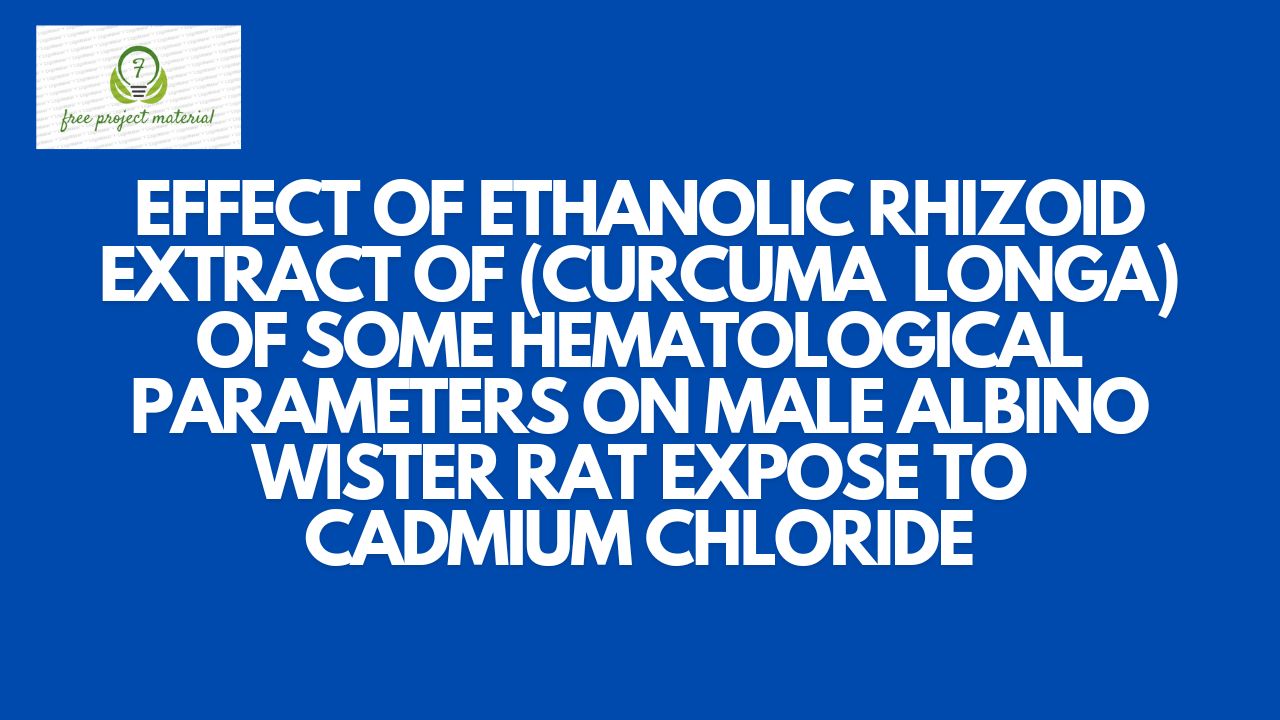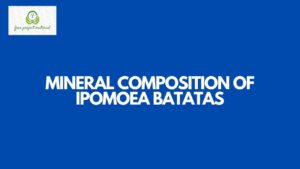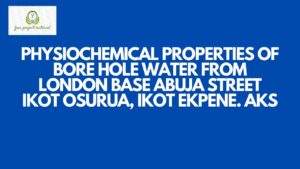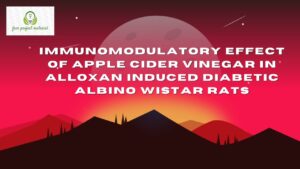ABSTRACT
The aim of the study is to determine the effect ethanolic extract of Curcuma longa on some hematological parameters of albino wistar rats exposed to cadmium chloride. Twenty (20) male albino rats were randomly assigned five (5) groups of four (4) rats in each group. Group 1 served as normal control and was fed with commercial rat chow and distilled water. Group 2 was treated with 30% LD50 of cadmium chloride every four days for 17 days and thereafter with commercial rat chow and distilled water adlitum. Group 3, 4 and 5 were treated with 30% of LD50 of cadmium chloride every four days for seventeen (17) days, thereafter 100 mg/kg body weight, 200 mg/kg body weight and 300 mg/kg body weight of ethanolic extract of Curcuma longa daily for 17 days respectively. At the end of the 34 days the rats were starved overnight and was sacrifice. Blood was collected through cardiac puncture and serum was used for determination of some hematological parameters. The result of the biochemical assay revealed a non-significant decrease (P>0.05) in white blood cell, lymphocyte, monocyte, basophil and MCHC in the treatment groups compared to the control while neutrophil and eosinophil showed non-significant increase compared to the control. Conclusively, Curcuma longa has the tendency to boast some hematological parameter and therefore might be recommended as blood boaster.
TABLE OF CONTENT
Title Page – – – – – – – – – i
Certification – – – – – – – – ii
Dedication – – – – – – – – – iii
Acknowledgement – – – – – – – iv
Abstract – – – – – – – – – v
Table of Content – – – – – – – – v-xi
CHAPTER ONE: INTRODUCTION
1.1 Background of the Study – – – — – – 1-4
1.2 Aim and Objectives of the Study – – – – 5
1.2.1 Aim of the study- – – – – – – – 5
1.2.2 Objectives of the study- – – – – – – 5-6
1.3 Scope and Limitation of the Study – – – – 6-7
CHAPTER TWO: LITERATURE REVIEW
2.1 Taxonomical classification and description of turmeric- – 8
2.1.1 Phyto Component of Turmeric – – – – – 9
2.2 Phyto Pharmacology of Turmeric – – – – 9-10
2.2.1 Antioxidant Activity – – – – – – 10-11
2.2.2 Cardiovascular and Anti-Diabetic Effect – – – 11
2.2.3 Anti-inflammatory and Edematic Effect – – – 12
2.2.4 Anti- microbial activity – – – – – – 12-13
2.2.5 Hepato protective and Reno protective effects – – 13-14
2.2.6 Anti-cancer effect – – – – – – – 14
2.3 Sources of Cadmium Exposure – – – – 14
2.1.3 Environmental Exposure to Cadmium – – – 14-15
2.3.2 Food Contamination by Cadmium – – – – – 15-16
2.3.3 Occupational Exposure – – – – – – 16
2.4 Effects of Cadmium Toxicity – – – – – 17-19
2.5 Diagnosis and Treatment of Cadmium Toxicity – – 19-20
2.6 Types of White Blood Cells and Their Functions – – 20-21
2.6.1 Lymphocyte – – – – – – – 21-22
2.6.2 Monocyte – – – – – – – – 22-23
2.6.3 Neutrophil – – – – – – – – 23-24
2.6.4 Eosinophil – – – – – – – – 24-25
2.6.5 Basophil – – – – – – – – 25-26
2.6.6 MCHC – – – – – – – – 26-28
2.7 Disorders of White Blood Cells – – – – – 28-30
2.8 Effect of Curcuma longa on White Blood
Cell Differential – – – – – – – 31-38
CHAPTER THREE: MATERIALS AND METHODS
3.1 Materials – – – – – – – – 39
3.1.1 Chemicals/Reagent used – – – – – – 39-41
3.1.2 Preparation of Reagent – – – – – – 42
3.2 Equipment Used/Model – – – – – – 42-43
3.2 Method – – – – – – – – 42
3.2.1 Sample Collection and Preparation – – – – 42-43
3.2.2 Experimental Design/ Treatment – – – 43-45
3.3 Collection of Blood Sample and Analysis – – – 45-46
3.4 Determination of Some Hematological Parameters (s) – 46-48
3.5 Statistical Analysis – – – – – – 48
CHAPTER FOUR: RESULTS AND DISCUSSION
4.1 Result s – – – – – – – – 49-51
4.2 Discussion – – – – – – – – 51-56
CHAPTER FIVE: CONCLUSION AND RECOMMENDATION
5.1 Conclusion – – – – – – – – 57
5.2 Recommendation – – – – – – – 57-58
References
CHAPTER ONE: INTRODUCTION
1.1 Background of the study
Medicinal plant have investigated a reliable source for preparation of new drugs combating diseases from the dawn of civilization, curcuma longa is a sterile plant pigment fit high slender with thick and fleshly underground stems, Rhizome are fermented dried and ground to produce bright yellow colouring pigment power regarded as essential diatory species with medicinal values rich in phenolic compounds widely distributed in warm areas of Asia African, cultivated in India, china and other tropical region (Khejehdehi, 2012).
Turmeric is chained effective inhibitor of many diseases such as treatment of sun exposure induced skin ageing, increase thickness and reduction of elasticity of skin, curcumin posses anti-inflammatory anti-immunities modulatory and antiatherogenic activity, it is a potent inhibitor of various reactive oxygen generating enzyme, indigenous herbal medicine for the treatment of inflammatory and liver disorder, antioxidative properties of curcumin is documented as a potent scavenger of reactive hydroxyl radicals, it has been reported to inhibit erythrocyte lipid peroxidation and serve as immune boaster in prevention of various bacteria’s and fungi penetrating into the white blood cells, white blood cells (WBC) Also known as leukocyte are cells of the immune system which protect the body against infectious disease and foreign invader. An increase in white blood cells above the normal range is called (leukocytosis) meanwhile a decrease level of white blood cells is called (Leukopenia), these indicate a weaken immune system some possible causes include genetics disorder, carcinogenesis and neoplasia. curcuma longa play an essential role in it immunities in rejecting tissue which are antigenically different to the recipient, it also protect b-cell and the t-cell in it lymphocytic levels to make antibodies that bind to pathogens invasion activated in the complement system and enhance pathogen destructions meanwhile the t-cells make cytokines and perform other functions that coordinate the immune responses in HIV infection, the t-cell are the main index to identify individual immune system integrity (Borra, 2013).
Curcumin administration attenuated the arsenic, gentamicin and acetaminophen induced oxidative stress in rat curcumin prevent free radical formation induced myocardial ischemia and lungs injury in rat it’s protected against diazinon- induced toxicity in blood liver and erythrocyte of male albino Wistar rats (Agurre et al., 2012).
Medicinal investigation claim it powder for the treatment of gastrointestinal diseases especially for biliary and hepatic disorder, diabetic wound rheumatism sinutis anorexia coryza and cough, curcumin is been authenticated as anti-cancer, anti-fertily and anti-venom, hepato protective nephor protective , it anti-coagulant prevent blood clothing in the basophil level of the white blood cells through the release of Heparin and histamine a chemical that aid in the body defense, recent study as also shown to posses anti-HIV activity causes by multiplicity of infection and replication of viral genes (Ammon, 2012). these medicinal properties of turmeric is considered as spice with multifunctional properties.
Cadmium chloride is white crystalline compound of cadmium and chloride usually it salt is hydroscopically solid highly soluble in water slightly soluble in alcohol, it present in the environment as pure metal most often as complex oxides sulphide and carbonate, cadmium accumulates in liver, kidney and bone whereby it toxicity result in carcinogenesis, the cirtical health effect of ingesting cadmium damages the kidney (blood filtration system) and also result in protein being excreted in urine, it effect depend on duration and magnitude of exposure, the level of diatory exposure can exceed the guidelines set by the united nation of food and agriculture organization (FAO) world health organization WHO according to the available data, thus the present study is aimed to assess the effect of ethanolic extract of curcuma longa of some Hematological parameters using the male albino Wistar rats.
1.2 Aim and objectives of the study
1.2.1 Aim of the study.
The aim of this research work is to determine the effect of ethanolic Rhizoid Extract of Curcuma longa of some Hematological parameters, expose to cadmium chloride in male albino wistar rats
1.2.2 Objectives of The Study
The objectives of this study are:
i) To examine the effect of ethanolic extract of turmeric on the white blood cells level of the albino Wistar rat exposed to cadmium chloride
ii) To examine the effect of ethanolic extract of turmeric on the lymphocyte level of the albino Wistar rats exposed to cadmium chloride
iii) To examine the effect of ethanolic extract of turmeric on the neutrophil level of albino Wistar rat exposed to cadmium chloride
iv) To examine the effect of ethanolic extract of turmeric on the eosinophil levels of albino Wistar rat exposed to cadmium chloride
v) To examine the effect of ethanolic extract of turmeric on the basophil level of albino Wistar rat exposed to cadmium chloride
vi) To examine the effect of ethanolic extract of turmeric on the monocyte level of albino Wistar rat exposed to cadmium chloride
vii) To examine the effect of ethanolic extract of turmeric on mean corpuscular Hemoglobin centration level of albino Wistar rat Exposed to cadmium chloride
1.3 Scope and Limitation of the Study
The design of this work is to investigate and assay to the effect of ethanolic Rhizoid Extract of (Curcuma longa) of some Hematological parameters on male albino Wistar Rat expose to cadmium chloride.
The limitation encountered during the course of this work include
- Poor electricity supply for proper processing of the sample
- Financial constraint
- Ease to access to analytical instrument for rapid analysis of the sample
- Lack of standard environment, adequate and conductive atmosphere work. to carry out practical and analytical



